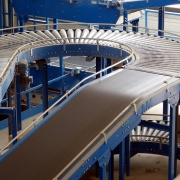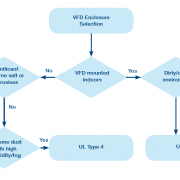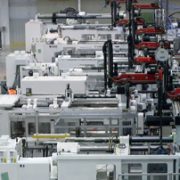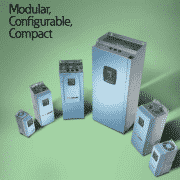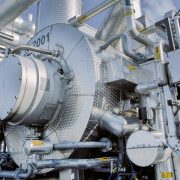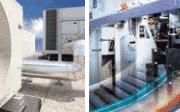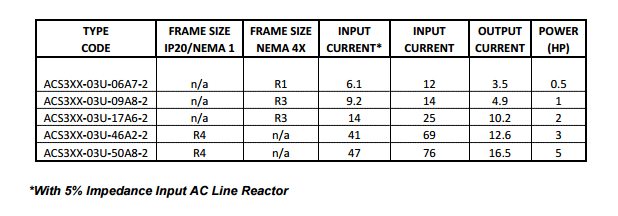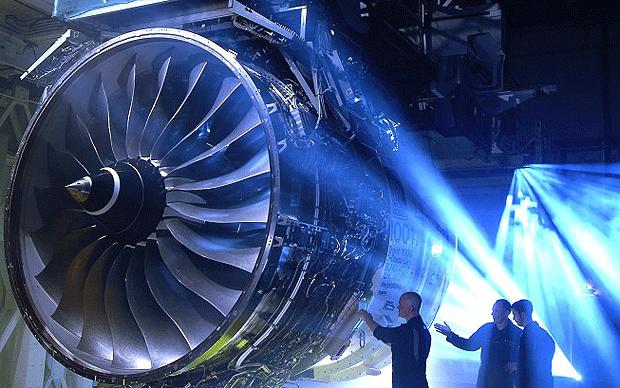Variable frequency drive manufacturers offer products to be used with electric motors.A variable frequency drive is also known as a VFD, variable speed drive, adjustable speed drive, electronic motor controller, or an inverter. Every VFD is unique with its own component characteristics; so, how each VFD works is dependent upon components within the VFD. Most VFDs integrate a solid state electronics controller, consisting of a bridge rectifier, a converter, and an inverter module. Properly applied variable frequency drives can significantly reduce production operating costs.
Variable Frequency Drive Manufacturers: ABB
ABB low voltage drives are used globally. ABB low voltage drives are designed specifically for the following industries: textile, material handling, mining, cement, rubber and plastics, food and beverage, consumer goods, automotive, oil and gas, pulp and paper, water filtration, and waste water treatment. ABB manufactures specific products for each of these industries to provide the best possible performance while keeping cost to an absolute minimum.
ABBmicro drivesinclude models ACS55 and ACS150. ABB micro drives are very easy to install and set up. ABB micro drives provide flexible mounting alternatives and straightforward configuration for many basic applications. Each drive is tested before it leaves the factory providing high machineavailability. ABB local customer and technical support is available no matter where ABB micro drives are delivered and installed. ABBmachinerydrives include models ACS55, ACS150 and ACS355. ABB machinery drives are designed to meet the production and performance needs of machine builders, system integration specialists, panel builders and end users. ABB machinery drives can be flexibly programmed to meet the demands of different machine solutions. A wide range of features and options provide optimal solutions.
ABB ACS880single drivesare complete drives and can be installed without any additional cabinet or enclosure. ABB single drive modules configuration contains a rectifier, optional EMC filter, reactor, DC link and an inverter in one single AC drive unit. ABB single drives are available as wall-mounted, free-standing and cabinet-built constructions. The key features of ABB single drivesare programmability and configurability during both ordering and commissioning, which makes adaptation to different applications easy. ABBs ACS880multi-drivesare mounted into a cabinet and the complete assembly isoffered and delivered as one package. Often, the multi-driveswill include additional accessories such as contactorsand earth fault protection units. ABBmulti-drives are built from ABB industrial drive modules connected to a common DC bus. This enables a singlepower entry and common braking resources for several drives.This construction simplifies the total installation, and results in many benefits, including: savings in cabling, reducedinstallation and maintenance costs, reduced line currents and more.ABB multi-drives are built-to-order products.ABB is one of several variable frequency drive manufacturers offered by Precision Electric.
Variable Frequency Drive Manufacturers: Eaton / Cutler Hammer
Eaton/Cutler Hammer drives are system drives designed for simple to complex applications. Eaton SVX9000 drives are used in Sullair air compressor applications throughout the United States. Eaton SVX9000 drives are also used globally in oil refineries, marine vessel, power distribution and alternative energy applications. Eaton’sSVX9000adjustable frequency drive offers sensorless vector control technology coupled with an adaptive motor model and sophisticated ASIC circuit features.. This technology allows for steady speed error, fast torque rise time, high immunity to resonance vibrations and high starting torque and current. TheSVX9000is suitable for multiple motor drive systems and high-speed applications.EatonSPX9000drives are designed specifically for high-performance applications. EatonSPX9000drives feature high processing power and the ability to use information from an encoder or a resolver to provide precise motor control. In addition, a fast microprocessor provides high dynamic performance for applications where good motor handling and reliability are required.Eaton is one of several variable frequency drive manufacturers offered by Precision Electric.
Variable Frequency Drive Manufacturers: Lenze Americas
Lenze Americas drives are mainly used for any application that does not require speed feedback. Lenze drives are built in America and are an inexpensive solution for food processing, packaging machinery, materials handling, conveying systems, and HVAC systems. The SMV series ofLenzedrives range from IP31 (NEMA 1) and IP65 (NEMA 4/NEMA 4X) in power ratings from 120V to 240V through 480V and600V. The SMV series of Lenzedrives offer sophisticated auto-tuning, fast dynamic toque response with impressive low-speed operation all from a compact and simple to use package. The SMV range is designed for motor applications where dynamic speed and torque control is demanded, making the units ideal for conveyors, food production lines, packaging equipment plus fan & pump systems.The SMV series of Lenze drives use a price leadership tradition in the highly competitive AC drive market. With the benefit of a two year warranty, the SMV series of Lenzedrives offerperformance and flexibility make it an attractive solution for a broad range of applications.
The SMV series ofLenzedrives use price leadership in delivering unparalleled performance and simplicity. The SMV series of Lenze drives is the right choice forperformance, power, packaging and intuitive programming. The Lenze SMV series of Lenze drives use anElectronic Programming Module (EPM) for programming. The Lenze EPM makes for ease of hassle-free reconfiguration within each parameter or resetting the drive to factory or user default settings. When drive reset is necessary, reset to factory default or customer settings in seconds with the EPM. When the EPM equipped drive is used on a line containing multiple drives with the identical setup, it takes just minutes to program the entire line. TheEPM’s can be replaced with or without power connected. When a drive must be replaced, the parameter configuration is not lost, simply plug in the pre-programmed EPM. Lenze is one of several variable frequency drive manufacturers offered by Precision Electric.
Variable Frequency Drive Manufacturers: Hitachi
Hitachi AC Variable frequency drives are utilized for an array of applications. Hitachi drives are equipped with several advanced features and deliver unprecedented performance and reliability. Hitachi drives are a result of high degree of commonality between models and user friendly configuration software making them easy to install, program and maintain. The SJ700DHitachi inverter is designed with more capabilities and functions of its predecessor, the Hitachi SJ700B Series. SJ700D inverters come with improved sensorless vector (SLV) control algorithm, which allows the SJ700D Series to develop 150% torque at 0.5 Hz, ideal for a wide range of applications. Another key upgrade in the SJ700D Series is the addition of Hitachi’s EzSQ (Easy Sequence) built-in programming function, which provides the functionality of a PLC built into the inverter.
SJ700D inverters offer built in programming functions. Sequence operations are used by downloading programs created with Hitachi’s EzSQ software and then transferred to the Hitachi inverters. Operation of SJ700D inverters can be tailored to meet changing process requirements and SJ700D inverters can replace separate PLC’s in some cases to simplify or eliminate external hardware, which reduces cost and increases performance. SJ700D Hitachi inverters through 150kW have a built-in EMC filter to reduce electromagnetic noise, cost and space.SJ700Dinverters have a lifetime warning function to allowpreventive maintenancebefore a failure occurs.
The Hitachi industrial WJ200 Series AC Variable FrequencyDrives range from 100-200V single phase input to three phase output, and 200-240V three phase input / output, and 390-480V three phase input / output. The WJ200 Variable Speed Drive comes with an integrated auto-tuning function for easy sensorless vector control that provideshigh starting torque of 200% or greater, suitable for a variety of applications. Hitachi is one of several variable frequency drive manufacturers offered by Precision Electric.
For variable frequency drive repair or replacement quotes, contact Precision Electric.


